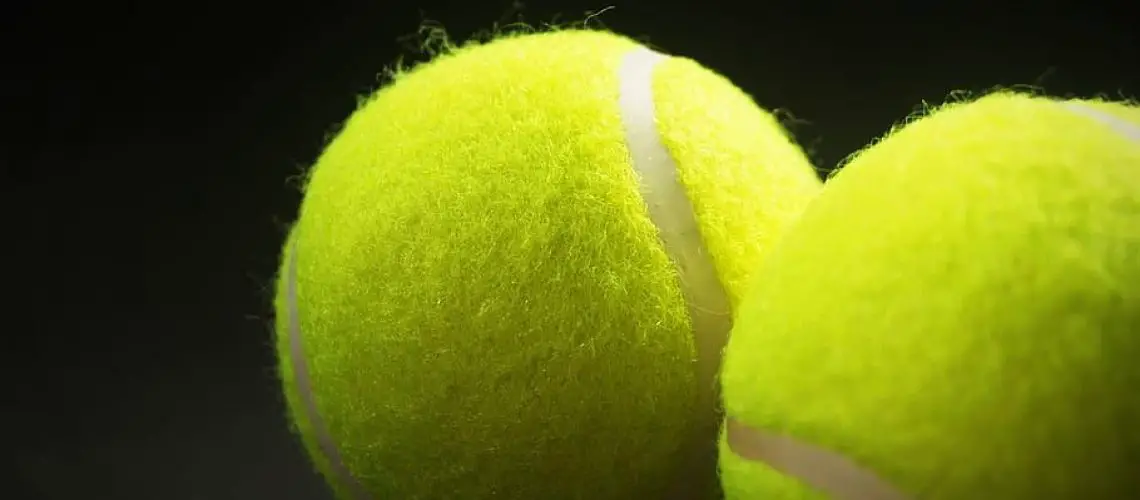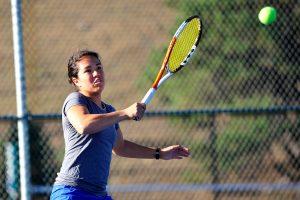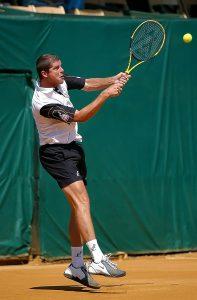We may earn money or products from the companies mentioned in this post.
How To Play Professional Tennis: The Ultimate Guide

Tennis, a sport known for its elegance and intensity, holds a significant place in the world of sports culture Whether you dream of competing on the grand stages of Wimbledon or simply want to elevate your game to a professional level, this guide will provide you with invaluable insights and strategies to help you navigate the path towards becoming a pro tennis player
The Path to Becoming a Pro Tennis Player
Becoming a professional tennis player requires dedication, perseverance, and a deep love for the sport It is not an easy journey, but with the right mindset and consistent effort, it is absolutely achievable Here are some key steps to consider:
-
Start Early:
Many professional tennis players begin their training at an early age Starting young allows ample time for skill development and physical conditioning -
Get Proper Coaching:
Finding a knowledgeable coach who can guide you through proper technique, strategy, and mental preparation is crucial -
Master the Fundamentals:
Building a solid foundation in basic strokes such as forehand, backhand, serve, and volley is essential before moving on to advanced techniques -
Develop Physical Fitness:
Tennis requires agility, speed, endurance, and strength Regular fitness training should be an integral part of your routine -
Participate in Tournaments:
Competing in local tournaments will expose you to different playing styles and help you gain valuable match experience under pressure -
Pursue Competitive Opportunities:
As your skills progress, seek out higher-level competitions such as national junior events or college tennis programs that offer scholarships -
Consider Professional Training Academies:
Enrolling in a reputable tennis academy can provide specialized training, exposure to top-level competition, and connections within the industry
Goals of the Article
The primary goal of this article is to equip aspiring tennis players with a comprehensive understanding of the journey towards becoming a professional player By providing insights into key steps and strategies, we aim to empower readers to take actionable steps towards their tennis dreams Whether you are just starting out or have been playing for years, this guide will serve as a valuable resource on your path to success
Introduction to Singles Tennis

Tennis, a sport that combines athleticism, strategy, and precision, has captivated players and spectators alike for centuries Within the realm of tennis, singles tennis stands out as one of the most intense and exhilarating forms of the game In this blog post, we will explore the essence of singles tennis, its historical roots, and why mastering this discipline can elevate your overall performance on the court
Definition and Brief History of Singles Tennis
Singles tennis is a variant of the game where two players face off against each other on opposite sides of the net The objective is to hit the ball over the net in such a way that your opponent cannot return it within the boundaries of the court The player who successfully accumulates more points wins
The origins of singles tennis can be traced back to 19th-century England when it gained popularity among aristocrats as a leisure activity Over time, it evolved into a competitive sport played at both amateur and professional levels around the world
Importance of Learning Singles Tennis for Overall Improvement in the Sport
Mastering singles tennis provides numerous benefits that extend beyond simply excelling in one particular form of play The skills developed through playing singles can greatly enhance your overall performance in tennis as a whole
Firstly, singles tennis forces you to rely solely on yourself during matches This cultivates mental toughness and self-reliance, as every shot you take directly affects your success or failure on the court It enhances decision-making abilities under pressure while sharpening strategic thinking skills
Secondly, singles requires exceptional physical fitness due to its demanding nature The constant movement across the court improves agility, speed, endurance, and coordination – all vital components for success in any form of tennis By focusing on singles, you can elevate your overall athleticism and improve your ability to handle matches of any intensity
Objective of the Blog: Guide on How to Play Singles Tennis Effectively
The main objective of this blog is to provide aspiring tennis players with a comprehensive guide on how to play singles tennis effectively We will delve into various aspects such as technique, footwork, shot selection, mental strategies, and match preparation
Through practical tips and insightful advice, we aim to equip you with the knowledge necessary to excel in singles tennis Whether you are a beginner looking for guidance or an experienced player seeking to refine your skills, this blog will serve as a valuable resource on your journey towards becoming a formidable singles player
Basic Rules and Regulations for Playing Singles Tennis

Tennis is a game of skill, strategy, and finesse Before stepping onto the court, it’s important to familiarize yourself with the basic rules and regulations that govern singles tennis From court dimensions to scoring systems, understanding these fundamentals will set you up for success on the court
Court Dimensions and Markings Specific to Singles Play
In singles tennis, the court dimensions remain the same as in doubles play However, there are specific markings that come into play:
-
Singles Sidelines:
The outermost lines on each side of the court define the boundaries for singles matches -
Baselines:
These lines run parallel to the net at each end of the court They mark the farthest boundary from which players serve and return shots -
Service Boxes:
Located on either side of the centerline, service boxes are where players must stand when serving They are marked by lines extending from the net towards the baselines
Scoring System and Terminology Used in Singles Matches
The scoring system in singles tennis consists of points, games, and sets Here’s a breakdown of how it works:
-
Points:
Players earn points by winning rallies The first player to accumulate four points wins a game -
Tiebreaks:
If both players reach a 6-6 tie in games during a set, a tiebreak is played to determine who wins that particular set -
Deuce and Advantage Points:
When both players reach 40-40 (also known as deuce), one player must win two consecutive points to secure the game The first point earned after deuce is called “advantage” If the same player wins the next point, they win the game; otherwise, it goes back to deuce
Essential Rules Every Player Should Know
Understanding and following these essential rules will ensure fair play and a smooth match:
-
Serving Rules:
Proper serving technique is crucial in tennis Players must toss the ball correctly, without touching or stepping on the baseline before hitting it Foot faults, where a player’s foot touches or crosses over the baseline during service, result in a fault -
Boundaries for Shots Played in a Singles Match:
It’s important to stay within the court boundaries when playing shots If a ball lands outside of the lines, it is considered out Additionally, if a player allows the ball to bounce twice before returning it, their opponent earns the point
By familiarizing yourself with these basic rules and regulations for singles tennis, you’ll be equipped with the knowledge needed to enjoy competitive matches while adhering to fair play guidelines
Preparation and Essential Skills for Playing Singles Tennis

Tennis is a physically demanding sport that requires players to be in top shape When it comes to playing singles tennis, the physical conditioning becomes even more crucial A singles player needs to have exceptional stamina and speed to excel on the court
Physical Conditioning Required for a Singles Player
1 Stamina Building Exercises:
To endure long rallies and intense matches, singles players must focus on building their stamina Incorporating aerobic exercises like running, cycling, or swimming into their training routine can help improve cardiovascular endurance High-intensity interval training (HIIT) is also beneficial as it simulates the intermittent bursts of energy required during a match
2 Speed Training Drills:
In singles tennis, quickness and agility are paramount Players must be able to move swiftly around the court to reach shots effectively Speed training drills such as ladder drills, cone drills, and shuttle runs can enhance footwork and reaction time Additionally, plyometric exercises like box jumps and lateral hops can improve explosive power
Critical Techniques Necessary to Master as a Singles Player
1 Serve – Flat, Spin, Kick Serves Explained:
The serve is arguably the most critical shot in tennis as it initiates each point A singles player must develop different types of serves to keep opponents off balance The flat serve generates power and speed, while the spin serve utilizes topspin or slice for more control The kick serve adds height and bounce to create difficulty for returners
2 Groundstrokes – Forehand, Backhand Variations (One-Handed and Two-Handed):
Solid groundstrokes are vital for dominating rallies in singles play Players need to master both forehand and backhand strokes, using variations such as topspin, slice, and flat shots Some players prefer a one-handed backhand for added reach and versatility, while others opt for the stability of a two-handed backhand
3 Volleys – Forehand Volleys, Backhand Volleys, Half-Volleys:
Net play is essential in singles tennis, and mastering volleys can be a game-changer Singles players must practice forehand and backhand volleys to effectively finish points at the net Additionally, learning half-volleys is crucial for handling low balls and maintaining control during fast-paced exchanges
4 Returns – First Serve Returns, Second Serve Returns, Attacking Weak Serves:
A strong return game can put pressure on opponents from the start Singles players should focus on developing their ability to return first serves with accuracy and consistency They also need to capitalize on second serves by attacking weak offerings with aggressive returns that disrupt the opponent’s rhythm
By incorporating these physical conditioning exercises and mastering key techniques, singles tennis players can elevate their game to new heights With improved stamina, speed, and skill set, they will be well-prepared to conquer the challenges of singles play on the court
Strategies to Excel at Singles Tennis

In order to become a formidable singles tennis player, it’s crucial to develop an aggressive mindset while playing matches This means actively seeking opportunities to take control of the game and dictate the pace By approaching each point with a proactive attitude, you’ll be able to put pressure on your opponent and keep them on their toes
Learning how to read opponents’ gameplay patterns and weaknesses effectively
is another key aspect of excelling at singles tennis By carefully observing your opponent’s serving patterns, you can anticipate where their shots will go and position yourself accordingly Additionally, recognizing weak backhand or forehand strokes can give you a strategic advantage, allowing you to target those areas during rallies
Adapting your game plan
is essential when facing different opponents To counter their strengths and exploit weaknesses, consider employing various strategies such as the serve and volley approach or baseline rallies The serve and volley technique involves rushing towards the net after serving, putting pressure on your opponent to make quick decisions under time constraints On the other hand, baseline rallies focus on staying consistent while applying constant pressure through powerful groundstrokes
Mastering the mental aspect of singles tennis
is just as important as honing your physical skills Staying focused during crucial points can make all the difference between winning and losing a match This requires discipline in eliminating distractions and maintaining concentration throughout each set Additionally, learning how to deal with nerves in tight match situations will allow you to perform at your best under pressure
Conclusion: Summarizing tips for success in Singles Tennis

In conclusion, achieving success in singles tennis requires a combination of factors that go beyond skill and technique It is essential to understand the importance of practice and dedication, as well as the value of mental toughness in overcoming obstacles By applying these tips and strategies outlined in this blog, readers can enhance their performance on the court and take their game to new heights
The importance of practice and dedication
Practice makes perfect, and this holds true for singles tennis To excel in this sport, it is crucial to devote time and effort into honing your skills through consistent practice By setting aside regular practice sessions, you can improve your technique, footwork, and overall fitness levels Dedication is equally important; staying committed to your training regimen will help you build endurance, speed, agility, and stamina
The value of mental toughness in overcoming obstacles
Tennis is not just a physical game; it also demands mental strength and resilience Developing mental toughness allows players to overcome challenges on the court effectively This includes learning how to stay focused during matches, managing stress or pressure situations, maintaining a positive mindset even when faced with setbacks or failures, and believing in oneself Cultivating mental toughness will enable you to perform at your best under any circumstances
Encouraging readers to apply the tips and strategies outlined in the blog
Now that you have gained valuable insights into the key factors for success in singles tennis – practice, dedication, and mental toughness – it’s time to put them into action! Take these tips seriously by incorporating them into your training routine Set specific goals for yourself both on and off the court Remember that progress takes time but with perseverance and determination together with these strategies mentioned above will undoubtedly lead to improvement in your singles tennis game
Useful Links

Fundamentals of Sound Singles Tennis Strategy
Tennis rules: Know how to play
7 Tennis Singles Strategies To Learn
Singles Tennis
Basic rules of tennis
Tennis Scoring: Points, Sets & Games | Tennis Rules
An Overview of the Sport of Tennis: Singles and Doubles
SINGLES TENNIS RULES – Recreational Sports
Should You Play Singles or Doubles?
Tennis games for three players (and other awkward …
5 Smart Plays To Use In 5 Common Scenarios In Singles …
Singles Strategies for High School Players
Tennis Singles Strategy – Control The Four Zones In Tennis
Tennis Rules
Types of tennis match
How to Play Tennis: The Beginner’s Guide to Tennis – 2023






